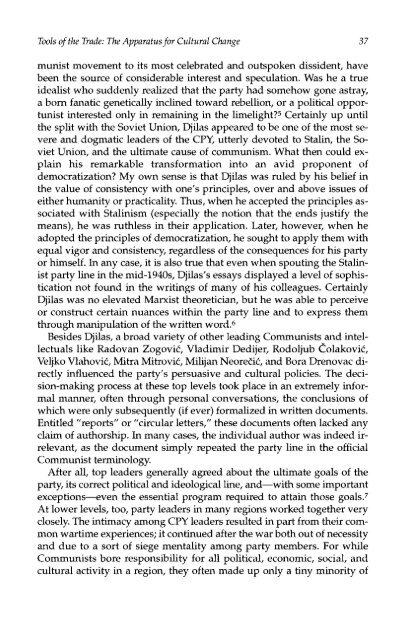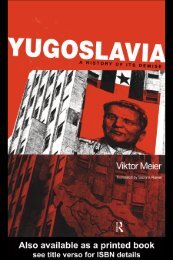Part Two - Indymedia
Part Two - Indymedia
Part Two - Indymedia
You also want an ePaper? Increase the reach of your titles
YUMPU automatically turns print PDFs into web optimized ePapers that Google loves.
Tools of the Trade: Tlte Apparatus for Cultural Change 37<br />
munist movement to its most celebrated and outspoken dissident, have<br />
been the source of considerable interest and speculation. Was he a true<br />
idealist who suddenly realized that the party had somehow gone astray,<br />
a born fanatic genetically inclined toward rebellion, or a political opportunist<br />
interested only in remaining in the limelight 5 Certainly up until<br />
the split with the Soviet Union, Djilas appeared to be one of the most severe<br />
and dogmatic leaders of the CPY, utterly devoted to Stalin, the Soviet<br />
Union, and the ultimate cause of communism. What then could explain<br />
his remarkable transformation into an avid proponent of<br />
democratization My own sense is that Djilas was ruled by his belief in<br />
the value of consistency with one's principles, over and above issues of<br />
either humanity or practicality. Thus, when he accepted the principles associated<br />
with Stalinism (especially the notion that the ends justify the<br />
means), he was ruthless in their application. Later, however, when he<br />
adopted the principles of democratization, he sought to apply them with<br />
equal vigor and consistency, regardless of the consequences for his party<br />
or himself. In any case, it is also true that even when spouting the Stalinist<br />
party line in the mid-1940s, Djilas's essays displayed a level of sophistication<br />
not found in the writings of many of his colleagues. Certainly<br />
Djilas was no elevated Marxist theoretician, but he was able to perceive<br />
or construct certain nuances within the party line and to express them<br />
through manipulation of the written word. 6<br />
Besides Djilas, a broad variety of other leading Communists and intellectuals<br />
like Radovan Zogovic 1 , Vladimir Dedijer, Rodoljub Colakovic 1 ,<br />
Veljko Vlartovic:, Mitra Mitrovi^, Milijan Neoredic, and Bora Drenovac directly<br />
influenced the party's persuasive and cultural policies. The decision-making<br />
process at these top levels took place in an extremely informal<br />
manner, often through personal conversations, the conclusions of<br />
which were only subsequently (if ever) formalized in written documents.<br />
Entitled "reports" or "circular letters," these documents often lacked any<br />
claim of authorship. In many cases, the individual author was indeed irrelevant,<br />
as the document simply repeated the party line in the official<br />
Communist terminology.<br />
After all, top leaders generally agreed about the ultimate goals of the<br />
party, its correct political and ideological line, and—with some important<br />
exceptions—even the essential program required to attain those goals. 7<br />
At lower levels, too, party leaders in many regions worked together very<br />
closely. The intimacy among CPY leaders resulted in part from their common<br />
wartime experiences; it continued after the war both out of necessity<br />
and due to a sort of siege mentality among party members. For while<br />
Communists bore responsibility for all political, economic, social, and<br />
cultural activity in a region, they often made up only a tiny minority of
















